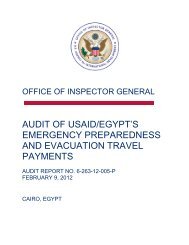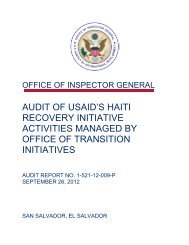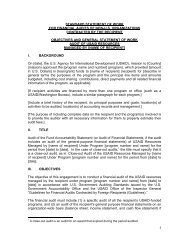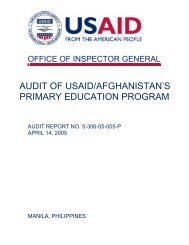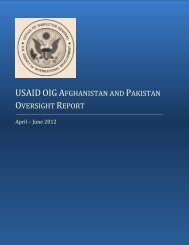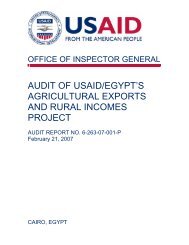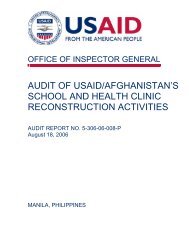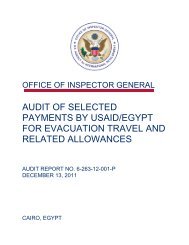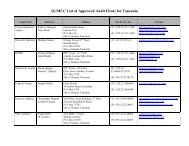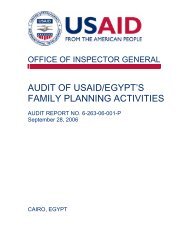Audit of USAID/Haiti's Public Law 480 Title II Programs
Audit of USAID/Haiti's Public Law 480 Title II Programs
Audit of USAID/Haiti's Public Law 480 Title II Programs
You also want an ePaper? Increase the reach of your titles
YUMPU automatically turns print PDFs into web optimized ePapers that Google loves.
The audit also supports the results <strong>of</strong> a study referenced by TOPS showing that the care groupmodel is the more cost-effective method for reaching wide audiences. For instance, while WorldVision succeeded in reaching more than 90 percent <strong>of</strong> its target population with BCC, it was lessefficient than ACDI/VOCA. Only 9 mothers on average were trained in mothers’ clubs versus100 trained in ACDI/VOCAs’ mother care groups. In addition, World Vision’s clubs had a ratio<strong>of</strong> 50 percent paid personnel supporting its clubs compared with ACDI/VOCA’s ratio <strong>of</strong>10 percent (as in the chart below). By using the traditional mothers’ clubs (using fewerresources than World Vision), CRS reached at least 600 more mothers than ACDI/VOCA did.However, CRS started out with almost half <strong>of</strong> its mothers’ clubs carried over from its previous<strong>Title</strong> <strong>II</strong> program, and ACDI/VOCA didn’t start using the care group model until FY 2011.Mothers’ Clubs Summary (Unaudited)Element World Vision ACDI/VOCA CRSNumber <strong>of</strong> mothers’ clubs 1,950 38 253Number <strong>of</strong> mothers receiving BCCmessages17,500 3,800 4,405Mothers trained per club 9 100 17Percent <strong>of</strong> coverage in targetlocationGreater than 90 34 Not trackedNumber <strong>of</strong> paid people assistingclubs299 40 16Number <strong>of</strong> unpaid volunteersassisting clubs300 380 190Total people assisting clubs 599 420 206Percent volunteers 50 90 92Percent paid personnel 50 10 8Sources: World Vision, ACDI/VOCA, and CRS.Thus, World Vision reached a large number <strong>of</strong> beneficiaries, but was not as cost-effective asACDI/VOCA. While CRS was more cost-effective, it reached fewer mothers than would havebeen possible had it used the care group model (and potentially reduced the incidence <strong>of</strong> childmortality and stunting by a greater percentage). The data suggest that incorporation <strong>of</strong> thismethodology could have increased the BCC received by program beneficiaries at less cost if allthe sponsors had adopted the care group model when MYAP began.The cooperating sponsors used mothers’ clubs as the main vehicle for disseminating BCC tobeneficiaries. The next MYAP also requires effective use <strong>of</strong> BCC interventions for improvingnutrition, hygiene, and health practices, however, leaving implementation methodology to thepotential awardees to propose. Although <strong>USAID</strong>/Haiti <strong>of</strong>ficials say the care group model isgood, they do not want to recommend one model over another without further validation;however, there is no way to validate the model during this MYAP because that is not part <strong>of</strong>FFP’s programing. The MYAPs are awarded through cooperative agreements that permitcooperating sponsors to adopt their own activity models. FFP will participate in validatingactivity models only if a cooperating sponsor suggests it. Therefore, the <strong>Title</strong> <strong>II</strong> program is notgeared to make sure that the greatest possible development impact is achieved.To improve the implementation <strong>of</strong> <strong>Title</strong> <strong>II</strong> activities related to mothers’ clubs, we make thefollowing recommendations.7



